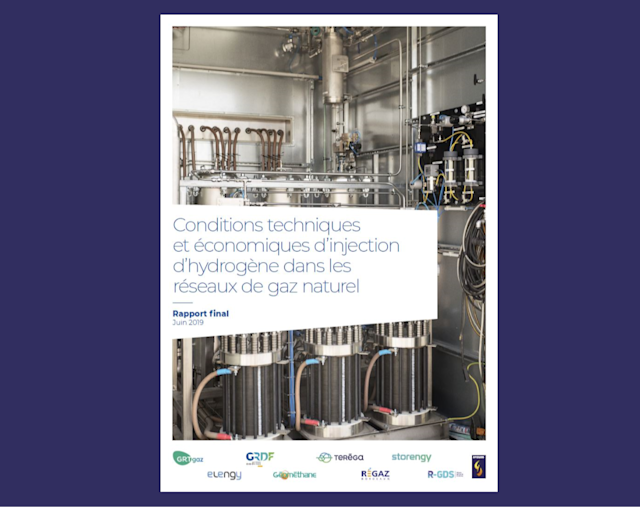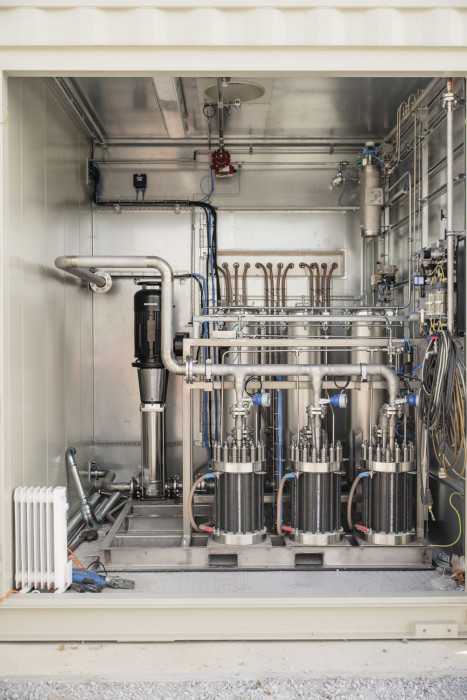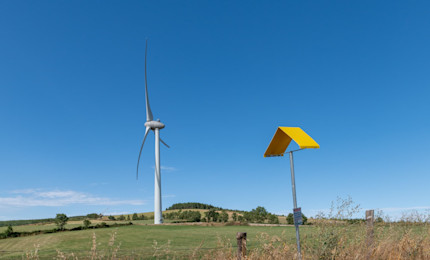Urgence gaz 0 800 028 800

Hydrogen: an essential energy form for the energy transition
Although we tend to talk of hydrogen as a the energy of the future, its use is, in reality, quite long established in industry. The current challenge for the energy transition is to decarbonise hydrogen production. Solutions exist. The issue now is to develop them on a large scale, constructing a hydrogen industry that can speed up developments in its use.
What is hydrogen?
Hydrogen (H2) is an element found in abundance in the universe. This invisible, colourless gas is however rarely found in its pure state. It is found most notably in the composition of water (H2O). Due to its chemical properties, it is used a great deal in industry (oil refining, ammonia production, glass production etc.). But it also has valuable energy properties.
That means hydrogen can also be used:
to provide heat, by injecting it into the gas grid, or directly,
as a vehicle fuel, using a fuel cell that produces electricity,
to store and produce electricity which will be injected into the electricity grid,
as a chemical for refineries or fertiliser production (ammonia).
Strictly speaking, hydrogen is not an energy source; it is an energy carrier that must be produced and stored before it can be used. Today the most common method of hydrogen production is steam reforming. This technique, based on fossil fuels, is a source of greenhouse gas emissions. That is why a variety of solutions are being researched to move across to decarbonised hydrogen production: electrolysis of water, pyro-gasification etc.

Toward the expansion of a hydrogen industry
The expansion of the hydrogen sector will help overcome a two-fold challenge: to speed up the energy transition and strengthen the fabric of French industry. The reason is that the fine-tuning of hydrogen-based solutions for sectors which are hard to decarbonise will be a factor for significant regional competitiveness and economic dynamism.
The Nicolas Hulot hydrogen plan, presented in 2018, launched three main areas of development for hydrogen in France:
Decarbonised hydrogen production for industry
In France today, hydrogen is chiefly used in industry. That market is estimated at 1 Mt, 94% of which is produced using fossil fuels. That production, which emits greenhouse gases, makes up 3% of France’s CO2 emissions nationally. The decarbonisation of industrial hydrogen is therefore a logical priority for French hydrogen policy.
That greening of the industry should be enabled by the large scale development of hydrogen production by electrolysis of water. A 100% renewable (water and electricity) production process, allowing the production of green hydrogen.
Hydrogen as a fuel for heavy vehicles
Hydrogen as a fuel is currently being envisaged chiefly for heavy vehicles: road, rail and river transport etc. Hydrogen can be used as an energy carrier in fuel cells to supply electric vehicles. Heavy vehicles or hydrogen powered cars emit only water vapour, making this a fitting solution for green mobility. Research is also under way to produce decarbonised synthetic fuels from hydrogen, such as ethanol, by the hydrogenation of CO2.
Storage of renewable electricity in the form of hydrogen
Electrolysis of water is also a way of exploiting surplus electricity produced from wind or solar energy. Indeed, the production of this renewable electricity is subject to natural events (sunshine, wind) and is therefore intermittent. The electricity cannot presently be stored over long periods or in large quantities. The rise of renewable electricity’s share of the world’s energy mix therefore requires the development of solutions to store that energy. Hydrogen production through electrolysis appears to be a suitable solution for storing the electricity.
Development of the hydrogen transport grid and storage
At Teréga, we have an ambition to contribute to the development of the hydrogen industry across our regions. As a gas infrastructure operator, our mission is to adapt our grid to facilitate the injection of renewable gases, including hydrogen, to enable their circulation between producers and consumers across France and Europe.
Hydrogen, Teréga and proactive gas operators
As part of the 2018 hydrogen plan, Teréga worked with other French gas operators on a joint report sent to the Ministry of Ecological and Inclusive Transition. That report sets out the technical and economic conditions for the integration of hydrogen into our infrastructures. An analysis that confirms the role of gas infrastructures in the rollout of hydrogen energy in France and achieving carbon neutrality in 2050.

Hydrogen for multi-energy grids
In addition to its energy benefits, hydrogen represents an opportunity for developing multi-energy grids. Accelerating the synergies between networks has become a significant challenge in the energy transition, to:
encourage an energy mix of increasing diversity, with the development of renewable energies,
improve energy efficiency: 25 to 60% of energy produced in France is lost.
Power-to-Gas consists in transforming electricity from renewable sources (wind, solar) to hydrogen by the electrolysis of water. The resulting renewable hydrogen (sometimes called green hydrogen) can then be:
stored in the form of hydrogen,
injected into the grid, mixed with natural gas,
converted into synthetic methane through methanation, by combining it with CO2,
used to produce electricity.

Electrolyser on the Jupiter 1000 project.
At Teréga, we are convinced that multi-energy is the route to energy transition. That is why we have worked alongside NaTran in building the first French industrial Power-to-Gas demonstrator: Jupiter 1000.
Teréga fully committed to supporting the development of the hydrogen market
Teréga has joined the European hydrogen storage alliance H2eart for Europe, tasked with accelerating the deployment of underground hydrogen storage, which is essential for supply flexibility.
Teréga is also a partner in the H2med green hydrogen corridor project, which will link the Iberian Peninsula to Central Europe, with a transport capacity of 2 million tonnes a year. The project has been selected by the European Commission as part of the 6th list of priority projects of common interest.
At the same time, Teréga is leading the Hydrogen South West Corridor of France (HySoW) project, a 600 km pipeline infrastructure integrated into the European grid, capable of transporting 16 TWh/year of carbon-free hydrogen across the south-west by interconnecting the major industrial and mobility hubs, a lever for the decarbonisation and reindustrialisation of the region. Thanks to its salt cavern storage capacity in Nouvelle-Aquitaine (500 GWh by 2030), developed in association with the Salins du Midi group, this project will offer invaluable flexibility for security of supply.








